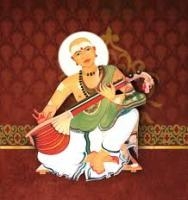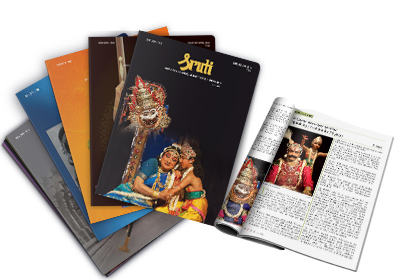
Muthuswami Dikshitar was born on 18 March 1775 at Tiruvarur as the eldest son of Ramaswami Dikshitar, who was himself a celebrated vaggeyakara. Dikshitar inherited knowledge of sangeeta sastra from his father. He also acquired proficiency in Sanskrit and had an exceptional command over its grammar and poetics. He had a deep knowledge of the Veda-s, the Upanishad-s, purana-s, tantra sastra, astrology and allied subjects. He was also a storehouse of information on temples—their deities, rituals, festivals, myths and legends. Through his musical compositions Dikshitar shared with seekers of learning his vast treasure of musical knowledge as well as the wealth of experience in religious and spiritual matters.
He had his share of depression and moments of stress and strain in life. But, instead of wallowing in them, he sublimated his personality and raised it to the level of the impersonal and lived at that higher level of consciousness throughout his life. Music for him was a medium to keep himself in constant contact with the Cosmic Consciousness whose manifestations he felt in all beings. Dikshitar’s deep knowledge of, and insight into various subjects, his poetic imagery and mastery of the Sanskrit language, his impersonal nature born of a contemplative mind—all these profoundly influenced his choice of themes. The scholarly style and the sublimity of thoughts contained in the sahitya are a delight to the savants, while the lyrical poetry and the sound of the rhymes in majestic Sanskrit give aural pleasure even to the layperson.
Normally I do not refer to the brochure issued along with the stamp. However, in this particular case I make a deviation, for it contains a well-written piece, both in style and content, on the music of the composer. The author’s name is not given, but it is evident that it was penned by a knowledgeable person.
After giving a brief biography of the composer, including his parentage, stay in Varanasi, his first composition in Tiruttani, his Navavarana and other samudaya kriti-s, and his demise at Ettayapuram on Deepavali day in 1835, the note proceeds to say: “Dikshitar has left a rich legacy to Carnatic music comprising a few hundred kriti-s in the Raganga Raga-s of Venkatamakhi and other raga-s existent in his time, a few group kriti-s on particular deities, ragamalika-s (kriti-s in which several raga-s figure), multilingual kriti-s, dance compositions and light tunes based on airs played on the brass band. No other composer of his time has tried his hand at so many varieties of compositions and with such signal success. The outstanding feature Dikshitar’s compositions is that they present a vivid, accurate and full picture of the raga employed and not merely some of the facets. To him, a raga was not a mere scale or assembly of swara-s but a divine form, beautiful and adorable. He was a master of the alap tradition as described in texts and fitted in the classical alap method into his kriti-s. His vision of the raga-s is, therefore, clear and comprehensive and his portrayal of them precise and rich. His songs are in slow measure (vilambit) with a few passages in the madhyama kala (drut) towards the end. His kriti-s bear the imprint of arduous veena practice and are noted for the graces and glides which are possible only on the veena.”


